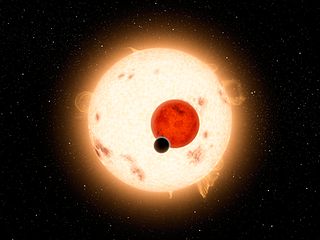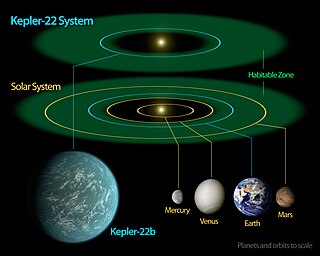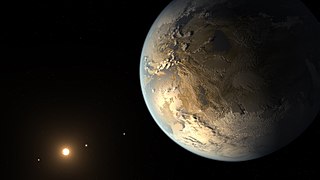Related Research Articles

An exoplanet or extrasolar planet is a planet outside the Solar System. The first possible evidence of an exoplanet was noted in 1917 but was not recognized as such. The first confirmation of the detection occurred in 1992. A different planet, initially detected in 1988, was confirmed in 2003. As of 1 December 2023, there are 5,550 confirmed exoplanets in 4,089 planetary systems, with 887 systems having more than one planet. The James Webb Space Telescope (JWST) is expected to discover more exoplanets, and also much more about exoplanets, including composition, environmental conditions and potential for life.

A terrestrial planet, telluric planet, or rocky planet, is a planet that is composed primarily of silicate rocks or metals. Within the Solar System, the terrestrial planets accepted by the IAU are the inner planets closest to the Sun: Mercury, Venus, Earth and Mars. Among astronomers who use the geophysical definition of a planet, two or three planetary-mass satellites – Earth's Moon, Io, and sometimes Europa – may also be considered terrestrial planets; and so may be the rocky protoplanet-asteroids Pallas and Vesta. The terms "terrestrial planet" and "telluric planet" are derived from Latin words for Earth, as these planets are, in terms of structure, Earth-like. Terrestrial planets are generally studied by geologists, astronomers, and geophysicists.

A Super-Earth is a type of exoplanet with a mass higher than Earth's, but substantially below those of the Solar System's ice giants, Uranus and Neptune, which are 14.5 and 17 times Earth's, respectively. The term "super-Earth" refers only to the mass of the planet, and so does not imply anything about the surface conditions or habitability. The alternative term "gas dwarfs" may be more accurate for those at the higher end of the mass scale, although "mini-Neptunes" is a more common term.

An exoplanet is a planet located outside the Solar System. The first evidence of an exoplanet was noted as early as 1917, but was not recognized as such until 2016; no planet discovery has yet come from that evidence. What turned out to be the first detection of an exoplanet was published among a list of possible candidates in 1988, though not confirmed until 2003. The first confirmed detection came in 1992, with the discovery of terrestrial-mass planets orbiting the pulsar PSR B1257+12. The first confirmation of an exoplanet orbiting a main-sequence star was made in 1995, when a giant planet was found in a four-day orbit around the nearby star 51 Pegasi. Some exoplanets have been imaged directly by telescopes, but the vast majority have been detected through indirect methods, such as the transit method and the radial-velocity method. As of 1 December 2023, there are 5,550 confirmed exoplanets in 4,089 planetary systems, with 887 systems having more than one planet. This is a list of the most notable discoveries.

Kepler-16b is an exoplanet. It is a Saturn-mass planet consisting of half gas and half rock and ice, and it orbits a binary star, Kepler-16, with a period of 229 days. "[It] is the first confirmed, unambiguous example of a circumbinary planet – a planet orbiting not one, but two stars," said Josh Carter of the Center for Astrophysics | Harvard & Smithsonian, one of the discovery team.

Kepler-22b is an exoplanet orbiting within the habitable zone of the Sun-like star Kepler-22. It is located about 640 light-years from Earth in the constellation of Cygnus. It was discovered by NASA's Kepler Space Telescope in December 2011 and was the first known transiting planet to orbit within the habitable zone of a Sun-like star, where liquid water could exist on the planet's surface. Kepler-22 is too dim to be seen with the naked eye.

Kepler-47c is an exoplanet orbiting the binary star system Kepler-47, the outermost of three such planets discovered by NASA's Kepler spacecraft. The system, also involving two other exoplanets, is located about 3,400 light-years away.

Kepler-62f is a super-Earth exoplanet orbiting within the habitable zone of the star Kepler-62, the outermost of five such planets discovered around the star by NASA's Kepler spacecraft. It is located about 980 light-years from Earth in the constellation of Lyra.

Kepler-90h is an exoplanet orbiting within the habitable zone of the early G-type main sequence star Kepler-90, the outermost of eight such planets discovered by NASA's Kepler spacecraft. It is located about 2,840 light-years, from Earth in the constellation Draco. The exoplanet was found by using the transit method, in which the dimming effect that a planet causes as it crosses in front of its star is measured.

Kepler-186f is an Earth-sized exoplanet orbiting within the habitable zone of the red dwarf star Kepler-186, the outermost of five such planets discovered around the star by NASA's Kepler spacecraft. It is located about 580 light-years from Earth in the constellation of Cygnus.

Kepler-438b is a confirmed near-Earth-sized exoplanet. It is likely rocky. It orbits on the inner edge of the habitable zone of a red dwarf, Kepler-438, about 472.9 light-years from Earth in the constellation Lyra. It receives 1.4 times our solar flux. The planet was discovered by NASA's Kepler spacecraft using the transit method, in which the dimming effect that a planet causes as it crosses in front of its star is measured. NASA announced the confirmation of the exoplanet on 6 January 2015.
Kepler-296e is a confirmed super-Earth exoplanet orbiting within the habitable zone of Kepler-296. The planet was discovered by NASA's Kepler spacecraft using the transit method, in which the dimming effect that a planet causes as it crosses in front of its star is measured. NASA announced the discovery of the exoplanet on 26 February 2014.
Kepler-296f is a confirmed super-Earth exoplanet orbiting within the habitable zone of Kepler-296. The planet was discovered by NASA's Kepler spacecraft using the transit method, in which the dimming effect that a planet causes as it crosses in front of its star is measured. NASA announced the discovery of the exoplanet on 26 February 2014.

A superhabitable planet is a hypothetical type of exoplanet or exomoon that may be better suited than Earth for the emergence and evolution of life. The concept was introduced in 2014 by René Heller and John Armstrong, who have criticized the language used in the search for habitable planets and proposed clarifications. According to Heller and Armstrong, knowing whether or not a planet is in its host star's habitable zone (HZ) is insufficient to determine its habitability: It is not clear why Earth should offer the most suitable physicochemical parameters to living organisms, as "planets could be non-Earth-like, yet offer more suitable conditions for the emergence and evolution of life than Earth did or does." While still assuming that life requires water, they hypothesize that Earth may not represent the optimal planetary habitability conditions for maximum biodiversity; in other words, they define a superhabitable world as a terrestrial planet or moon that could support more diverse flora and fauna than there are on Earth, as it would empirically show that its environment is more hospitable to life.
Kepler-26e is an exoplanet orbiting the star Kepler-26, located in the constellation Lyra. It was discovered by the Kepler telescope in February 2014. It orbits its parent star at only 0.220 astronomical units and completes an orbit once every 46.8 days. It is potentially habitable.
Kepler-186e is a confirmed exoplanet orbiting the red dwarf star Kepler-186, approximately 582 light years away from Earth in the constellation of Cygnus. It is near the optimistic habitable zone but probably not in it, possibly making it have a runaway greenhouse effect, like Venus. The exoplanet was found by using the transit method, in which the dimming effect that a planet causes as it crosses in front of its star is measured. Four additional planets orbiting the star were also discovered.
Kepler-395c is a potentially habitable exoplanet 616 light-years away in the constellation of Cygnus.

Kepler-1649c is an Earth-sized exoplanet, likely rocky, orbiting within the habitable zone of the red dwarf star Kepler-1649, the outermost planet of the planetary system discovered by Kepler’s space telescope. It is located about 301 light-years (92 pc) away from Earth, in the constellation of Cygnus.
Kepler-737b is a super-Earth exoplanet 669 light years away. There is a chance it could be on the inner edge of the habitable zone.
Kepler-167 is a K-type main-sequence star located about 1,119 light-years (343 pc) away from the Solar System in the constellation of Cygnus. The star has about 78% the mass and 75% the radius of the Sun, and a temperature of 4,884 K. It hosts a system of four known exoplanets. There is also a companion red dwarf star at a separation of about 700 AU, with an estimated orbital period of over 15,000 years.
References
- 1 2 3 4 5 Rowe, Jason F.; et al. (2014). "Validation of Kepler's Multiple Planet Candidates. III. Light Curve Analysis and Announcement of Hundreds of New Multi-planet Systems". The Astrophysical Journal. 784 (1): 20. arXiv: 1402.6534 . Bibcode:2014ApJ...784...45R. doi:10.1088/0004-637X/784/1/45. S2CID 119118620. 45.
- ↑ "Planet Kepler-298 d". Extrasolar Planets Encyclopaedia . Retrieved 26 April 2018.
